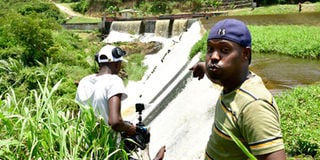Prime
Kitagwenda: The undiscovered haven in the west

What you need to know:
SEARCHING. Visiting Kitagwenda once again reminds one why Uganda is known as the Pearl of Africa. From rolling hills to valleys so lush, so green, it is guaranteed to take your breath away, writes, EDGAR R. BATTE.
Kitagwenda is not listed among must-see places on your popular local and international travel portals but three reasons should lead you to the almost virgin destination in western Uganda.
It is home to cycads, plants that were food for dinosaurs million years ago. Then, the magnificent, roaring beauty that is Mpanga Falls, capped in hills and valleys.
The artistic eye will be awed by the colour contrasts. At the bottom of the hills, are caves and greenery that make for good hiking. I bet you will break a sweat on that expedition that will last you three hours, and more as you manoeuvre through thickets and refreshing open air spots.
Some six hours on the road will get you to Kitagwenda, past Fort Portal and Kamwenge districts, from which it was carved. It is largely inhabited by a pastoral and crop farming community.
My initial visit was courtesy of Uganda Tourism Board (UTB), the agency in charge of marketing destination Uganda. They are undertaking efforts to diversify the country’s tourism products, away from the prized Mountain Gorilla that continues to rake in some good foreign forex.
They have partnered with tour and travel operator, Mackay Mwebingwa, of Hill Crest Safaris, to promote Kitagwenda’s tourism potential. Like South Africa’s Lake Eland Game Reserve, where you are sure to get your adrenaline rush, it is a matter of time and effort to turn Kitagwenda into an adventure destination too.
Even as is, the natural enclaves are inviting. I was grateful to have taken my most tiring yet satisfying nature walk. With a stick in hand, I didn’t initially have much use for it until I came face to face with steeps with soft dark, loam soils that necessitated every stamina I could use to make a descend.
For the fear of rolling over, stemming from the fear of heights, one of our hosts, extended his hand and gave me pointers on the best way to balance my way down the hills. To keep the fear at bay are imposing hills, with some hydro power lines running through and alongside roads within the green foliage that distinctively stand out against the blue and white clouds.
It is fascinating how daring locals here are. They graze their cattle along the slopes. Some have lost lives, along with their cows. Non-Government Organisations have come in to save the day by constructing boreholes and water points for locals and their animals.
The slopes lead to some of the coolest points, namely, the Mpanga Falls, the white roaring beauty that is sorrounded by lush green folliage. The power of the falls looks like a photography backdrop; too good to be real. but it is.
We find our way through some shrubs to get a sneak pic, and then extend further for our eyes to open unto more. From a powerful point, the water bubbles into stream speed and pours again into a robust bed. It is amazing that River Mpanga runs a distance across a number of district and still manages to exhibit such vigour. Here, nature and beauty can be shared in one sentence.
Take a nature walk
You will need to be fairly fit to take the nature walk through nature’s splendour in Kitagwenda. Otherwise, the guides are patient and willing to hold your hand and wait on for you as you catch your breath and let your muscles relax and revitalise to take a couple of more steps in the untamed countryside of gardens, bushes and caves.
Go chimpanzee tracking
Kibaale is close to Kitagwenda and popular for chimpanzee tracking in Kibaale National Park. According to Uganda Wildlife Authority (UWA), semi-autonomous government agency that conserves and manages Uganda’s wildlife, there are 13 species. Guided walks start at 8am and 2pm and last an average of three hours, depending on various factors. There is the Chimpanzee Habituation Experience (CHEX) that enables visitors to accompany researchers and habituators into the forest.
See cycads
Cycads are an ancient group of seed plants with a crown of large compound leaves and a stout trunk. They are a minor component of the flora in tropical and subtropical regions today, but during the Jurassic Period, they were a common sight in many parts of the world. Today only a handful of cycads still exist, and many are facing possible extinction in the wild.




